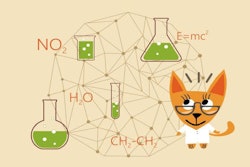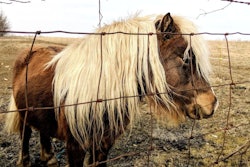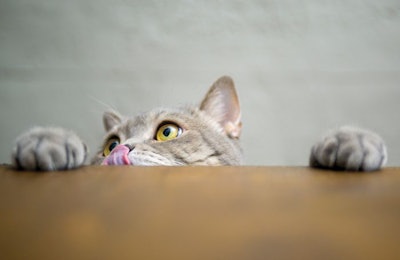
Grain-free pet food does big business. In spite of recent woes caused by the U.S. Food and Drug Administration (FDA) warning of a potential connection between canine dilated cardiomyopathy in dogs and a dog food diet with peas, lentils, other legume seeds or potatoes as main ingredients, the category continues to be one that nearly every pet food manufacturer eyes as a potential market. The majority of pet food brands offer at least one grain-free formula, according to Petfood Industry data, and some companies cater exclusively (or nearly so) to grain-free formulation.
That being said, the time has long passed where being “grain free” is enough of a differentiator to stand out in the market. With the category hitting critical mass, how can brands keep from getting lost in the fray?
‘Hypoallergenic’: a key phrase in the grain-free segment
A significant part of the origins of grain-free pet food has to do with allergies. As more and more pet owners began to see allergies developing in their dogs and cats, they went down the same path many humans do when dealing with their own allergies: diet. And while meat (particularly beef or chicken) is the No. 1 suspect for a pet with a food allergy, intolerances or allergies (veterinarian-confirmed or otherwise) to wheat, other grains began to pop up as a consumer concern.
So, pet food companies got to work on going grain free and, as with most trends in pet food that establish a firm foothold, it soon became about more than just striking wheat and corn from the ingredient label.
Merrick Pet Care, for instance, launched a line of limited-ingredient diet (LID) wet and dry dog foods in 2015 with grain-free recipes as a differentiator. But, “as competition increased, we saw an opportunity to improve our LID offerings to provide complete and balanced nutrition from a single source of animal protein, update the recipes to be potato-free and feature a more simplified ingredient list,” said Barbara Liss, vice president of marketing for Merrick.
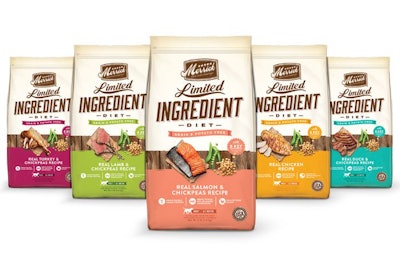
Merrick recently reformulated its Limited Ingredient Diets, which were already grain free, hitting additional consumer demands such as high protein and potato-free. | Photo courtesy Merrick Pet Care
So, that’s exactly what the company did. “As the trend towards health and wellness in pet food continues to grow, today’s nutrition-savvy pet parents are seeking high-quality, allergy-friendly food made from simplified ingredients that are easy to understand,” said Liss.
Entoma Petfood was founded in France a little less than two years ago specifically to answer the need for hypoallergenic options in pet food formulation in a unique (and now emerging) way: with insects. In the black soldier fly (Hermetia illucens), Entoma found a novel protein source that has multiple functions and benefits: it’s hypoallergenic, high in digestibility, rich in omega-3, -6 and -9, and a good source of calcium, among other things.
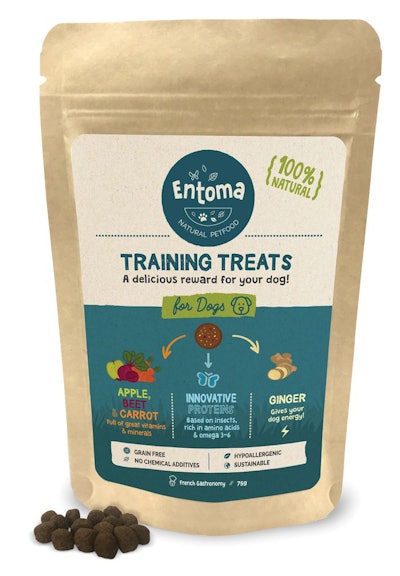
Entoma Petfood highlights insects as its chosen protein in its grain-free products, creating formulas that are hypoallergenic with regards to both meat and grain allergies. | Photo courtesy Entoma Petfood
“Grain free is very important today, because if you want to be a hypoallergenic and high-quality pet food brand, you have to be grain free,” said Rachelle Cantet, chief operating officer for Entoma. Using insects as a protein in grain-free formulas seemed to answer several consumer needs at once, covering possible allergens from both the grain side and the meat side, and it’s something pet owners have responded to.
According to Cantet, Entoma has gained a particular brand of customer, not necessarily drawn to the novelty of insects as an ingredient, but looking for answers regardless of the ingredient list.
“[One] type of customer we have comes to us mostly from cities, with a certain type of dog,” said Cantet. “Those dogs are very sensitive and have a lot of problems with their food. The owners were looking for different products, nothing ‘industrial,’ a little more tailor-made, and hypoallergenic. They wanted to try something new because their dog didn’t have a good response with even vet-prescribed products. Those people were very easy to capture.”
Other trends making their way into grain-free formulas
Naturally, grain-free pet food and treat manufacturers have taken other popular trends into account when trying to stand out in today’s market.
Old Mother Hubbard, owned by WellPet LLC, already had all-natural options when it came to dog treats, but in July 2018 the company decided to dive into the grain-free treats market with four new recipes meant to address dogs with food sensitivities involving grains.
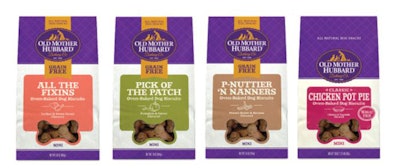
Old Mother Hubbard introduced grain-free and wheat-free dog treats in order to cater more strongly to dogs with grain sensitivities or allergies. | Photo courtesy WellPet
“We wanted to make sure dogs with grain sensitivities could also enjoy our oven-baked dog biscuits,” said Chris Hood, senior brand manager for Old Mother Hubbard. “With each of our new unique flavor combinations we’re giving pet parents more options to mix up snack time.” Three of the formulas are grain free, and a fourth is wheat free, according to the company, with flavor combinations such as turkey and sweet potato, pumpkin and carrot, and peanut butter and banana.
Adding additional enticements to dry kibble is a trend that is crossing the aisles as inclusions (for nutrition, as a treat or for the sake of customization) gain in popularity, and grain-free formulas are addressing that idea, as well.
“We’re seeing significant growth in the grain-free dry dog food recipes that feature inclusions like freeze-dried raw meat,” said Liss. Merrick’s Backcountry Raw Infused kibble recipes feature protein-rich, grain-free kibble with whole pieces of raw, freeze-dried meat, poultry or fish, combining some consumers’ desire to feed their pets a more “wild” diet with the need for convenience (in not having to prepare said diet) that nearly every pet owner looks for.
Entoma looks to its other strength for differentiation: eco-consciousness.
“We are grain free, but we are also a very eco-friendly company,” said Cantet. “We have a 100 percent natural product, a sustainable type of protein and sustainable way to work with our packaging. The company has always had a mindset of eco-friendliness. We really try to have good quality products.”
The eco-friendliness of the insects themselves is another reason why Entoma has built itself on this novel ingredient.
“Using insects [involves far] less CO₂ consumption when compared with beef, for example,” said Cantet. “Insects also use less water, because the worms used in our dry food and snacks — you don’t give them water to drink, they drink water in their food. Insect farming uses about 20 times less water than beef farming. Insects also use up a lot less land than beef. The environmental metrics of insect production are very interesting compared to other production.”
The future of grain-free pet food
Those in the grain free segment agree that other differentiators are needed to stand out on the market today. But what does the future hold for grain free, and what are pet food manufacturers aiming for as they look ahead?
“We believe that the future of the grain-free category is focused on recipes that are high in protein so they feature a taste that dogs love,” said Liss. The company’s recent improvements on its LID recipes show that Merrick intends to follow that belief, as the formulas now feature a single source of animal protein as the first ingredient, aiming for 26 to 30 percent protein content on the label. “Most importantly, the new recipes are designed to be more delicious than ever before.”
Another future trend is really a continuation and growth of a current trend: that of grain free as a subset of natural formulas.
“Almost all grain-free brands today claim natural,” said Cantet. “I think the trend with grain free is to go more and more natural. It will have to have lots of vegetables with interesting ingredients, no additives, no extra salt; I think most of the grain-free brands will go on that trend.”
In addition, finding other sources of carbohydrates will become more common, according to Cantet.
“More and more brands are doing advertising that involves other carbohydrates — such as peas, tapioca or sweet potatoes,” she said. “So, the future of grain free would be to find other sources of carbohydrates besides potatoes. Maybe a mix, or a completely different type instead of potatoes.”
Certainly, pet food manufacturers who deal in grain free have plenty to think about as they continue to navigate the increasingly crowded waters of pet store shelves.
The latest on FDA pet food ingredients and DCM





